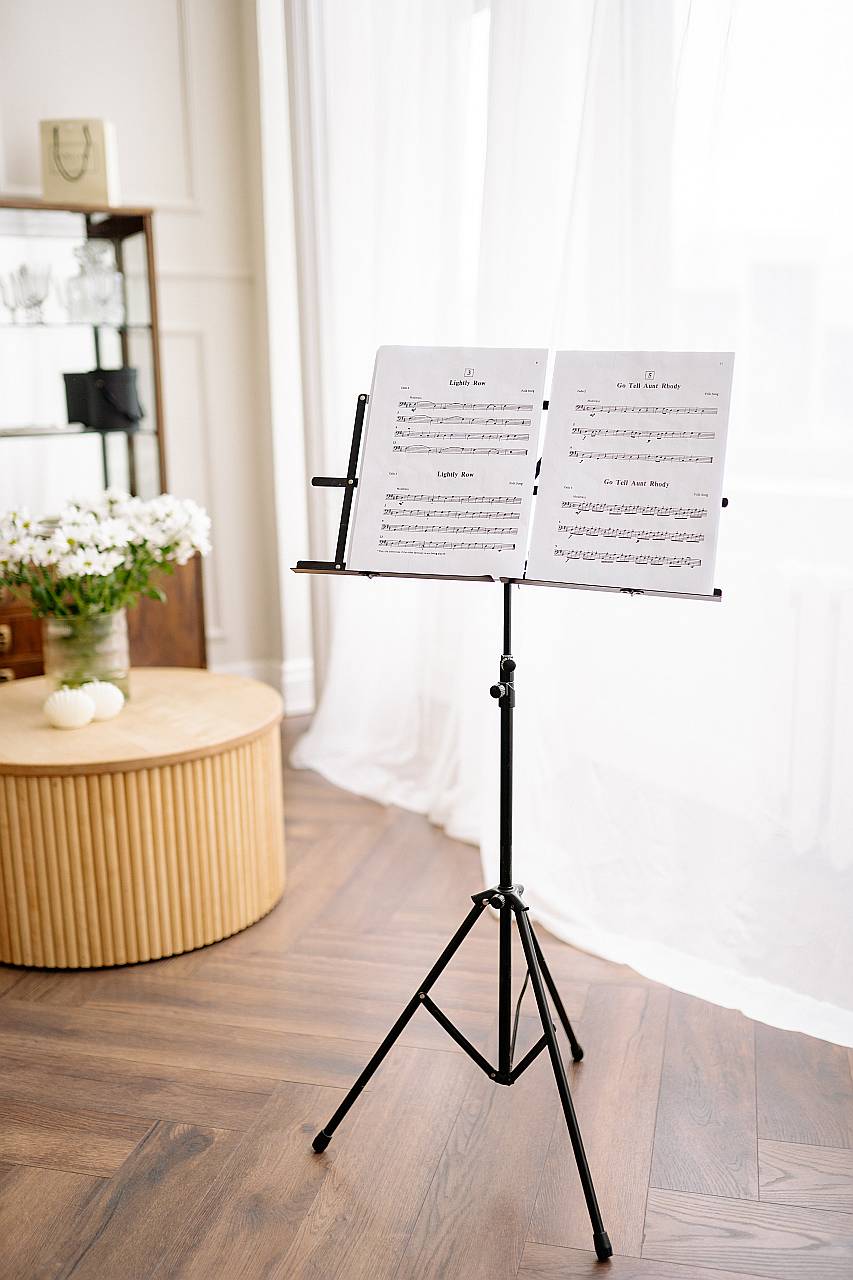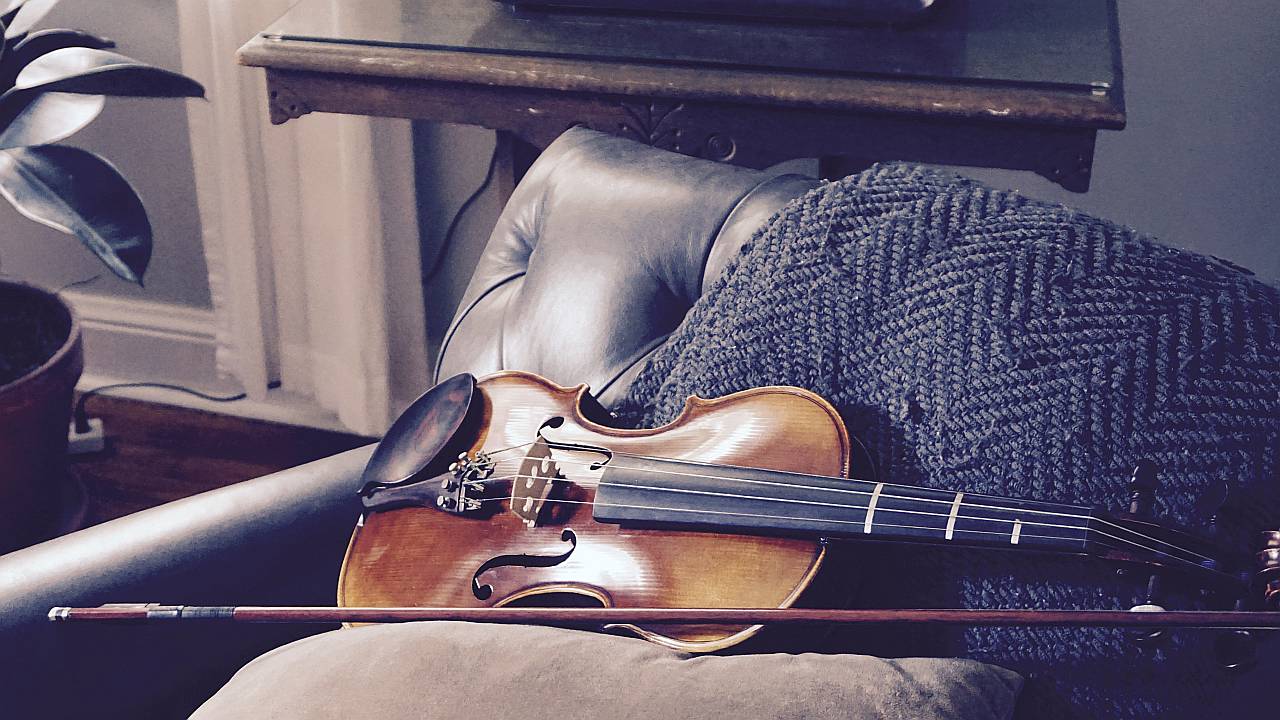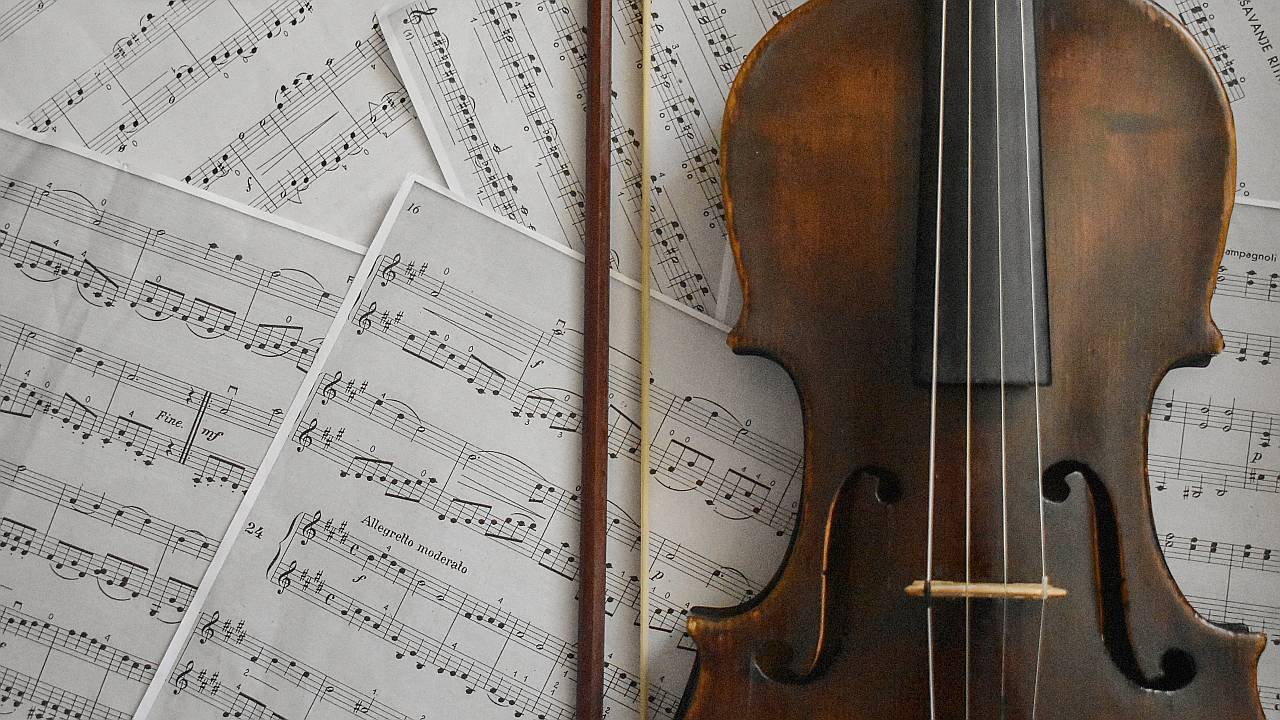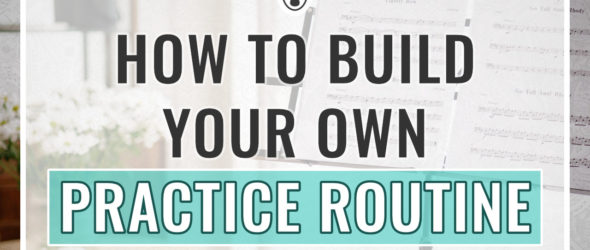Having a violin practice routine is very important to help improve your playing quickly and consistently. Developing any routine takes time, and getting started with it is one of the trickiest parts. Today I’ll talk about determining when to practice, for how long, and what to actually focus on in your daily violin practice.
I’m also including two separate practice plans for beginner and intermediate violin players to help you get started and to see how I would structure my routine around the specific music I’m learning.

Beginner Practice Plan
and Sheet Music

Intermediate Practice Plan
and Sheet Music
What is a Practice Routine?
A practice routine is the schedule you create to practice the violin consistently and with a focus. Your practice routine can consist of both the days you’ll practice, along with a breakdown of what each session will entail.
Creating a practice routine will help you manage your time and learn more music and techniques in a shorter amount of time. Your violin playing can only benefit from it!
My Practice Routine
Here I’d like to share with you my full practice routine:
1. Warm-up stretching
My practice routine begins by warming up my whole body with gentle stretching. I highly recommend stretching before practicing the violin to avoid injury. The violin is physically demanding, especially if you’re playing for a long period of time! Just like you might warm up before exercising, you’ll want to do the same before playing the violin.
If you’d like to learn some gentle stretches to warm up and cool down before and after your practice session, check out my video:
2. Scales & arpeggios
Then, I like to work on scales and arpeggios. I like to choose the scales I warm up with based on the music I’m learning.
3. Etude
Next, it’s time for an etude. I also pick one based on the music I’m working on. If there’s a technique I’m struggling with, I pick an etude that focuses on building that technique.
4. Piece
After I work through the etude, I’ll look at the trickiest spots in my music. After I’ve put in some good work in each chunk, I play through the piece to assess how it feels as a whole. This playthrough helps me determine what spots to focus on in my next practice session.
5. Fun
To finish out, I like to play something fun, just for my own enjoyment. I always try to end my sessions in a good mood. I find that this helps motivate me to play again the next day!
6. Cool-down stretching
Before moving on with the rest of my day, I finish out with a few stretches to cool down.
Sometimes I practice each of these steps in one large chunk of time, and other times I’ll split all this work up through an entire day, in smaller chunks of time. It all depends on my schedule and how I feel both mentally and physically.
How to Start
Start with just a few minutes of playing violin at a time. It can be very helpful to just use a small chunk of time in your day to play the violin and get used to the new habit.
Do you have 5 minutes? That’s great because you can do my 5-minute practice session for beginners!
If you’re having trouble finding not only the time to play but also motivation, my article How to Find Motivation to Practice Violin is full of tips that I’m sure you’ll find helpful!
Also, having a violin teacher can help you determine when to practice and they will recommend what specifically to work on. If you’d like to get an individual practice plan from a professional violin teacher, no matter if you’re just starting to play the violin or would like to get back on track after a long break, you can join my school – Julia’s Violin Academy! Request your invite today and start learning in a structured way from now on.

Creating Your Practice Routine
There are many factors to consider when you begin to create your practice routine. Here are the basics:
Find a good space for practicing
Having one space where you practice is important to build a habit and keep you focused. Your practice space can be as fancy as a dedicated room, or as simple as a corner of your living room or bedroom.
Try to keep this space free of distractions, like other people or a television. It might be a good idea to leave your cell phone in another room, unless you use apps on it to help you practice (like a tuner or a metronome).
Fill your practice space with the essentials
Once you have your own practice space figured out, it can be very helpful to leave your violin on an instrument stand or holder (as long as it’s safe – keep unattended instruments away from pets and small children!), and leave your sheet music sitting out on the music stand. This way, when you pass by, you’ll think about practicing the violin, and it’ll stay at the top of your mind. Out of sight, out of mind is absolutely true when you’re learning an instrument!

What is your goal?
Ok, so you want to be a violinist. That’s awesome! But a more specific goal will help you become one.
You can start with creating a list of pieces that you’d like to learn to play on your violin. Learning one piece from this list at a time can be your goal, or you can go deeper by specifying which techniques you need to learn in order to be able to play a given piece in the future.
To make it even more specific, choose a deadline. Depending on how broad is your goal, the time frame for achieving it can be one week, two weeks, a month, the whole autumn, or a year – you choose.
In the best-case scenario, your goal should be SMART, meaning:
- S for specific – it should be clear what you’re going to work on.
- M for measurable – how much time are you going to spend on your practice? Or, if you’re going to take an exam, you can simply aim for passing it.
- A for achievable – your goal should be ambitious, yet still realistic to achieve!
- R for relevant – is it the right time to do it? Does it help me achieve my ultimate goal of e.g. playing …put here your favorite style or piece… on my violin?
- T for time-bound – here goes your deadline.

Choose how often you’d like to practice
Realistically, how many days per week would you like to practice the violin? How many days each week do you think you could find time to practice?
Start with what you think is realistic. Maybe that’s every other day, maybe it’s every weekday, maybe it’s only on weekends. The most important thing you can do is stay consistent. Then you can focus on practicing more often to achieve your goal.
Choose a good time of day
After everything is set up, you’ll want to find a good time of day when you can consistently practice.
Ask yourself, “Is there a point in my schedule where I have a chunk of time to practice the violin?” A chunk of time can be as short as five minutes, or as long as even two hours. If you’re a busy person, find small time slots in your day or week when you can play the violin for even just a little bit. Remember, any time spent playing is better than no time spent at all!
When you’re brainstorming your practice routine, it’s very helpful to keep your practice sessions at around the same part of each day, just like how you might eat meals at around the same time; then it becomes a natural habit!

Finding the right length
After you’ve decided what time of day will work best, think about how long you’d like each practice session to last.
You’ll want them to be long enough to accomplish everything you’d like to get done, but not so long that you’re exhausted or unproductive.
I personally like to break up my practice into short sessions. I find that I can stay more focused and I’m less tired when I split up what I need to do into smaller chunks.
A short practice session is a great way to focus on just one idea at a time, and you can make this a great daily habit as well: you might use your first practice session to warm up, then practice scales around lunchtime, and your repertoire right after dinner.
Determine what to practice
Next, we need to decide what to actually work on! Here are a few questions to get started:
- What piece are you learning?
- What key is it in?
- What technique does this music focus on?
- What’s a technique you’d like to get better at?
- What’s the hardest spot in your music?
Your answers to these questions can determine what you should practice.
Whatever key your music is in, it can be the violin scale and arpeggio you use as a warm-up. The technique you’d like to get better at can be improved through an etude that focuses on it, and then you can focus on the hardest spot in your music.

Focus on what needs improvement
It can take a bit of time to determine what to practice based on what needs improvement in your own playing – first, you need to play through your music to see what you’d like to get better at.
After a bit of consistent practice, you’ll begin to see what needs improvement, and you can create a list of spots that need more in-depth practice.
You might notice that in one spot you accidentally play more than one string – in your next session, you might focus on your bow arm. Maybe you have trouble keeping a steady beat in another section – you can plan to look at that with a metronome later on.
Violin Practice Routine for Beginner
If you’re a beginner violinist, I’ve created a sample practice routine for you based on the piece Ode to Joy. You can download free violin sheet music and the practice plan here:

Beginner Practice Plan
and Sheet Music
Click here for detailed instructions on how to play Ode to Joy and bookmark this page to later practice with my play-alongs!
Do you need feedback on your playing? Make sure to upload your video here – Julia’s Violin Academy members only.
Violin Practice Routine for Intermediate Player
If you’re more of an intermediate-level violin player, I’ve also created a practice routine for you! I planned a full routine based on Küchler’s Concerto in D Major, which uses both first position and third position, and has a lot of tricky string crossings. My practice routine will help you focus on the techniques you need to master this concerto.
You can download the intermediate free violin sheet music and the practice plan here:

Intermediate Practice Plan
and Sheet Music
FAQ
Now, let’s have a look at frequently asked questions about the practice routine.
What is the best way to practice violin?
There’s no best or one correct way to practice the violin, but by creating your own practice routine you can find YOUR best way. Prepare your practice space, get the necessary equipment, and make sure to avoid distractions. Pick your goal, choose when to practice and for how long, plan ahead what to practice, then focus on improvements.
You might find that you only have the time for one practice session per day, and maybe that works for you. Or, you may have trouble focusing for long periods of time, and find that shorter sessions at different points of the day help you stay on track. Keep experimenting, and you’ll find the best way to practice violin for you.
How many hours a day should I practice violin?
How many hours a day you should practice the violin depends on many aspects, like your daily schedule, what is your goal, or to what practice time you are used to. In general, it can be from 5 minutes to 3 hours. A great habit is to practice 30 minutes every day.

Is 2 hours of violin practice a day enough?
There’s no perfect amount of practice time for everyone out there, but usually, 2 hours a day is enough, and productivity actually tends to wane after 2 hours. Experiment with how long you play the violin, and you’ll find something that works for your unique needs.
How many hours do professional violinists practice?
Some professionals will practice up to eight hours per day in their prime, but many, such as Itzhak Perlman, have said that practicing more than four hours a day can become very unproductive.
There’s a different limit for everyone, as we all have different schedules, different goals, and different mental and physical thresholds. Many professional violinists will break up their daily practice into short sessions where they focus on just one idea or piece of music. This is a great way to stay focused when you have a lot to work on!
Why is a practice routine important?
Practice routine is important because doing it consistently will help you retain the progress you make in each session, and will keep you in a routine of playing the violin. By following a daily practice routing, you’re creating a good habit, so with time, it will be easier to practice.
I find that once I fall out of the routine of playing the violin every day (or at least most days), it’s much harder to get back on track. Having a practice routine will help you see better, more consistent results and improvement in your playing.
Conclusion
I hope my tips will help you build your own unique practice routine. Remember, consistent practice will help you make fast progress! There are a lot of aspects to consider when creating your plan, so make sure to download the free practice routines (sheet music included) and start practicing right away!

Beginner Practice Plan
and Sheet Music

Intermediate Practice Plan
and Sheet Music
























